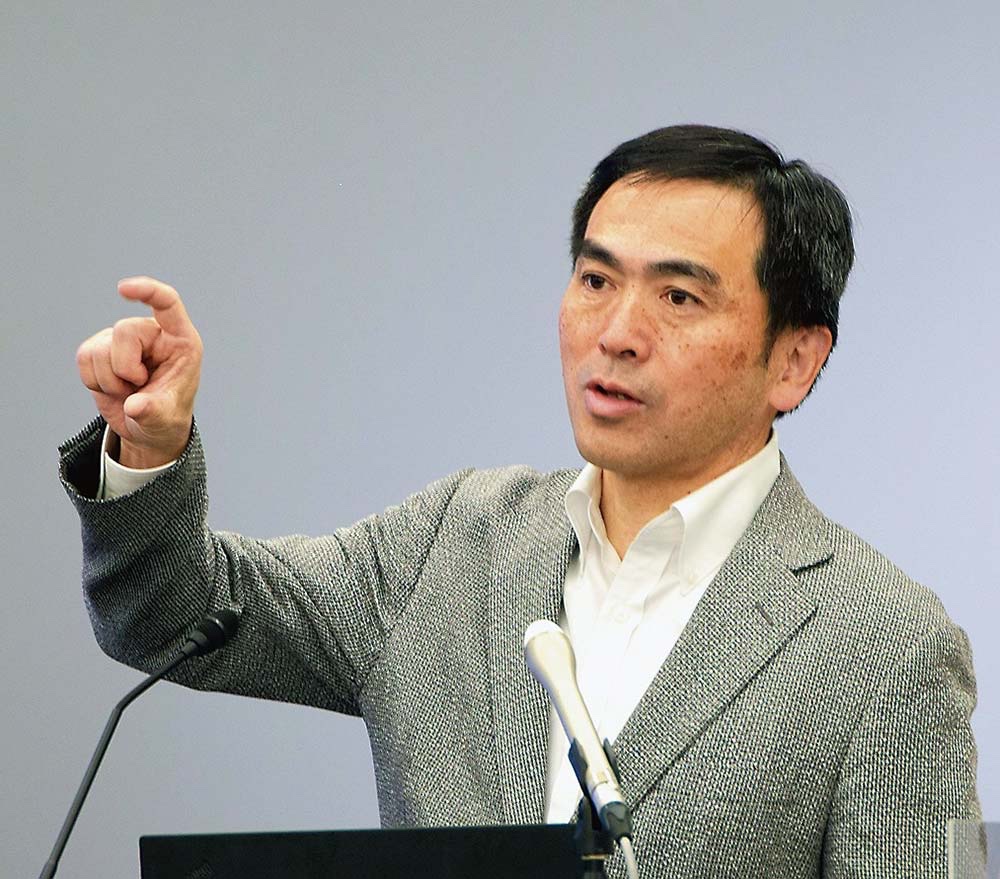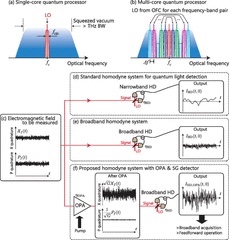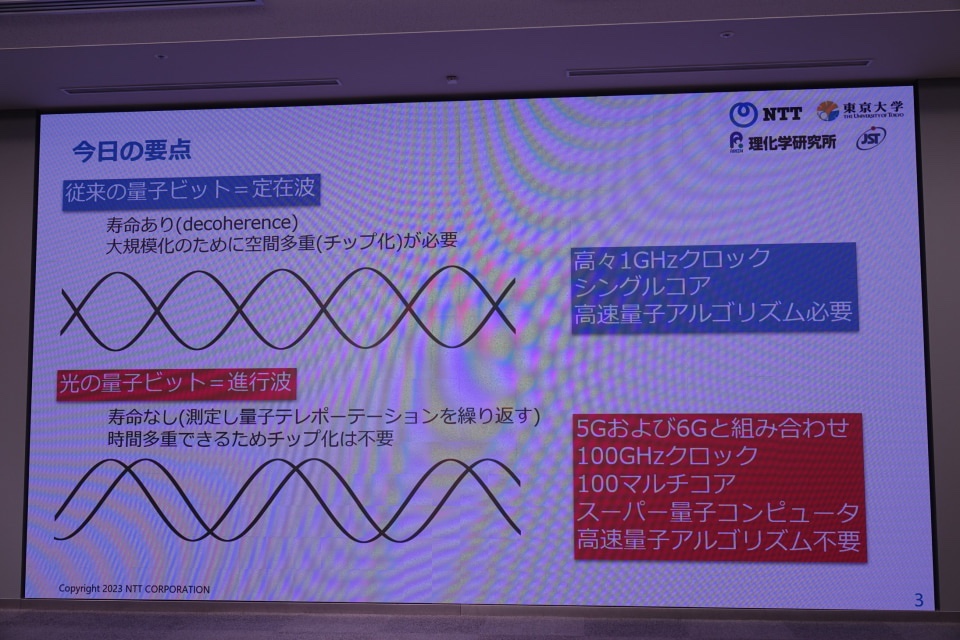


Super Quantum Computer: Fusion of Optical Communication and Photon Quantum!
– NTT succeeds in measuring real-time quantum signals at 43 GHz –
NTT
University of Tokyo,
RIKEN,
Japan Science and Technology Agency
-Four companies succeeded in real-time quantum signal measurement at 43 GHz-
Realize a super quantum computer, improve the performance of existing computers, and reduce power consumption.
Using “time domain multiplexing technology”:
-Realization of large scale and high speed-
It is a “measurement-induced optical quantum computer using time-domain multiplexing technology.”
Using traveling wave qubits:
– Do not use “standing wave qubits” –
It uses a “traveling wave qubit” in which photons arrive at high speed.
No device integration required:
By arranging “travelling wave qubits” on the time axis,
“When scaling up, there is no need to increase the size of the device or integrate the elements.”
Using “Optical Parametric Amplifier”:
-Amplifies light while preserving photon information-
We have developed a method to apply optical communication, which has been difficult until now.
Conventional problems:
Applying the detector for optical communication to the photon,
There was a problem that “the band can be secured, but the quantum information is degraded”.
again,
Photon detectors do not degrade the quantum information.
However, since the operating clock is several MHz, there was a problem that high-speed calculation was difficult.
Improvements this time:
The three researchers used an “optical parametric amplifier” using a PPLN waveguide.
This solved the problem and succeeded in “realizing high-speed computation and retention of quantum information.”
– Mobile Watch
https://k-tai.watch.impress.co.jp/docs/news/1483690.html
NTT: Measured the world’s fastest 43 GHz quantum signal!
– Toward the Realization of “Photon Quantum Computer” –
Optical quantum computer:
High speed of 100GHz band and
Combining 100 multi-core parallelism,
The realization of an “optical quantum computer” has become a reality.
NTT, etc.:
Combining “5G ultra-high-speed optical communication technology and optical quantum processor”,
We have developed a new technology for speeding up optical quantum computers.
Employs an “optical parametric amplifier”:
Due to nonlinear optical effects occurring in matter,
Allowing light of different wavelengths to interact with each other,
Use an “optical parametric amplifier”.
– Succeeded in amplifying light while preserving photon information –
Measure the world’s fastest 43 GHz real-time quantum signal.
Amplifies the photon state to a level that is not affected by optical loss.
Optical communication technology can be applied to the field of photonics.
Graduate School of Engineering, University of Tokyo
Professor Akira Furusawa
Current computer:
A large number of transistor gates are spatially arranged to perform large-scale calculations.
Even if it consumes a huge amount of power, the clock frequency is only about 1 gigahertz.
Innovative technology of optical communication:
“The new technology combined with optical communication will improve the calculation speed by more than 100 times.”
Combined with wavelength multiplexing of optical communication,
A 100 GHz clock, 100 core super quantum computer can be realized.
(Denpa Shimbun Digital)-Yahoo! News
https://news.yahoo.co.jp/articles/9a91b336822bfef9a53a76cad60ad7203ecbb73c
Ultrafast Quantum Computing: Successful 43 GHz Real-time Quantum Signal Measurement ~Toward Realization of His Super Quantum Computer by Fusion of Ultrafast Optical Communications and Photonics in the 5G Era~
https://www.t.u-tokyo.ac.jp/press/pr2023-03-07-001
Ordinateur super quantique : fusion de la communication optique et du photon quantique !
– NTT réussit à mesurer des signaux quantiques en temps réel à 43 GHz –
NTT
Université de Tokyo,
RIKEN,
Agence japonaise pour la science et la technologie
-Quatre entreprises ont réussi la mesure du signal quantique en temps réel à 43 GHz-
Réalisez un ordinateur super quantique, améliorez les performances des ordinateurs existants et réduisez la consommation d’énergie.
Utilisation de la “technologie de multiplexage dans le domaine temporel”:
-Réalisation à grande échelle et à grande cadence-
Il s’agit d’un “ordinateur quantique optique induit par la mesure utilisant la technologie de multiplexage dans le domaine temporel”.
Utilisation de qubits à ondes progressives :
– Ne pas utiliser de “qubits à ondes stationnaires” –
Il utilise un “qubit à ondes progressives” dans lequel les photons arrivent à grande vitesse.
Aucune intégration d’appareil requise :
En disposant des “qubits à ondes progressives” sur l’axe du temps,
“Lors de la mise à l’échelle, il n’est pas nécessaire d’augmenter la taille de l’appareil ou d’intégrer les éléments.”
Utilisation de “amplificateur paramétrique optique”:
-Amplifie la lumière tout en préservant l’information des photons-
Nous avons développé une méthode pour appliquer la communication optique, ce qui était difficile jusqu’à présent.
Problèmes classiques :
Application du détecteur de communication optique au photon,
Il y avait un problème que “la bande peut être sécurisée, mais l’information quantique est dégradée”.
encore,
Les détecteurs de photons ne dégradent pas l’information quantique.
Cependant, étant donné que l’horloge de fonctionnement est de plusieurs MHz, il y avait un problème en ce que le calcul à grande vitesse était difficile.
Améliorations cette fois :
Les trois chercheurs ont utilisé un “amplificateur paramétrique optique” utilisant un guide d’onde PPLN.
Cela a résolu le problème et a réussi à “réaliser un calcul à grande vitesse et la rétention d’informations quantiques”.
– Montre mobile
NTT : a mesuré le signal quantique 43 GHz le plus rapide au monde !
– Vers la réalisation de “Photon Quantum Computer” –
Ordinateur quantique optique :
Haut débit de la bande 100 GHz et
Combinant 100 parallélismes multicœurs,
La réalisation d’un « ordinateur quantique optique » est devenue une réalité.
NTT, etc. :
Combinant “la technologie de communication optique ultra-rapide 5G et le processeur quantique optique”,
Nous avons développé une nouvelle technologie pour accélérer les ordinateurs quantiques optiques.
Emploie un “amplificateur paramétrique optique”:
En raison des effets optiques non linéaires se produisant dans la matière,
Permettre à la lumière de différentes longueurs d’onde d’interagir les unes avec les autres,
Utilisez un “amplificateur paramétrique optique”.
– Réussi à amplifier la lumière tout en préservant l’information photonique –
Mesurez le signal quantique en temps réel de 43 GHz le plus rapide au monde.
Amplifie l’état du photon à un niveau qui n’est pas affecté par la perte optique.
La technologie de communication optique peut être appliquée au domaine de la photonique.
École supérieure d’ingénierie, Université de Tokyo
Professeur Akira Furusawa
Ordinateur actuel :
Un grand nombre de grilles de transistors sont agencées spatialement pour effectuer des calculs à grande échelle.
Même s’il consomme énormément d’énergie, la fréquence d’horloge n’est que d’environ 1 gigahertz.
Technologie innovante de communication optique :
“La nouvelle technologie combinée à la communication optique améliorera la vitesse de calcul de plus de 100 fois.”
Combiné avec le multiplexage en longueur d’onde de la communication optique,
Une horloge de 100 GHz, un ordinateur super quantique à 100 cœurs peut être réalisé.
(Denpa Shimbun Digital) – Yahoo Actualités
Calcul quantique ultrarapide : Mesure réussie du signal quantique en temps réel à 43 GHz – Réaliser un ordinateur super quantique en combinant communication optique ultrarapide et photonique à l’ère de la 5G –
Super-Quantencomputer: Fusion von optischer Kommunikation und Photonenquanten!
– NTT gelingt die Messung von Echtzeit-Quantensignalen bei 43 GHz –
NTT
Universität Tokio,
RIKEN,
Japanische Agentur für Wissenschaft und Technologie
-Vier Unternehmen gelang Echtzeit-Quantensignalmessung bei 43 GHz-
Realisieren Sie einen Super-Quantencomputer, verbessern Sie die Leistung bestehender Computer und reduzieren Sie den Stromverbrauch.
Verwendung der “Zeitbereichs-Multiplexing-Technologie”:
-Realisierung von großem Maßstab und hoher Geschwindigkeit-
Es ist ein “messinduzierter optischer Quantencomputer mit Zeitbereichs-Multiplexing-Technologie”.
Verwendung von Wanderwellen-Qubits:
– Verwenden Sie keine “Stehwellen-Qubits” –
Es verwendet ein „Wanderwellen-Qubit“, in dem Photonen mit hoher Geschwindigkeit eintreffen.
Keine Geräteintegration erforderlich:
Durch die Anordnung von „Wanderwellen-Qubits“ auf der Zeitachse
„Beim Hochskalieren muss weder das Gerät vergrößert noch die Elemente integriert werden.“
Verwendung von “Optical Parametric Amplifier”:
-Verstärkt Licht unter Beibehaltung der Photoneninformationen-
Wir haben eine Methode entwickelt, um die bisher schwierige optische Kommunikation anzuwenden.
Konventionelle Probleme:
Anwenden des Detektors zur optischen Kommunikation auf das Photon,
Es gab ein Problem, dass „das Band gesichert werden kann, aber die Quanteninformation verschlechtert wird“.
nochmal,
Photonendetektoren degradieren die Quanteninformation nicht.
Da jedoch der Betriebstakt mehrere MHz beträgt, gab es ein Problem, dass eine Hochgeschwindigkeitsberechnung schwierig war.
Verbesserungen diesmal:
Die drei Forscher verwendeten einen “optisch parametrischen Verstärker” mit einem PPLN-Wellenleiter.
Dadurch wurde das Problem gelöst und es gelang, „eine Hochgeschwindigkeitsberechnung und Speicherung von Quanteninformationen zu realisieren“.
– Mobile Uhr
NTT: Weltweit schnellstes 43-GHz-Quantensignal gemessen!
– Zur Realisierung des “Photonen-Quantencomputers” –
Optischer Quantencomputer:
Hohe Geschwindigkeit im 100-GHz-Band und
Kombination von 100 Multi-Core-Parallelität,
Die Realisierung eines “optischen Quantencomputers” ist Realität geworden.
NT usw.:
Kombinieren von “5G ultraschneller optischer Kommunikationstechnologie und optischem Quantenprozessor”,
Wir haben eine neue Technologie entwickelt, um optische Quantencomputer zu beschleunigen.
Verwendet einen „optisch parametrischen Verstärker“:
Aufgrund nichtlinearer optischer Effekte, die in Materie auftreten,
Licht unterschiedlicher Wellenlängen miteinander interagieren lassen,
Verwenden Sie einen “optisch parametrischen Verstärker”.
– Es gelang, Licht zu verstärken und gleichzeitig die Photoneninformationen zu erhalten –
Messen Sie das weltweit schnellste 43-GHz-Echtzeit-Quantensignal.
Verstärkt den Photonenzustand auf ein Niveau, das nicht durch optische Verluste beeinflusst wird.
Die optische Kommunikationstechnologie kann auf dem Gebiet der Photonik angewendet werden.
Graduate School of Engineering, Universität Tokio
Professor Akira Furusawa
Aktueller Rechner:
Eine große Anzahl von Transistor-Gates ist räumlich angeordnet, um groß angelegte Berechnungen durchzuführen.
Auch wenn es enorm viel Strom verbraucht, beträgt die Taktfrequenz nur etwa 1 Gigahertz.
Innovative Technologie der optischen Kommunikation:
“Die neue Technologie in Kombination mit optischer Kommunikation wird die Rechengeschwindigkeit um mehr als das 100-fache verbessern.”
Kombiniert mit Wellenlängen-Multiplexing der optischen Kommunikation,
Ein 100-GHz-Takt, 100-Core-Super-Quantencomputer kann realisiert werden.
(Denpa Shimbun Digital) – Yahoo!-Nachrichten
Ultrafast Quantum Computing: Erfolgreiche Echtzeit-Quantensignalmessung bei 43 GHz – Erreichen eines Super-Quantencomputers durch die Kombination von ultraschneller optischer Kommunikation und Photonik im 5G-Zeitalter –
Toward a multi-core ultra-fast optical quantum processor:
43-GHz bandwidth real-time amplitude measurement of 5-dB squeezed light using modularized optical parametric amplifier with 5G technology:
Applied Physics Letters: Vol 122, No 10
ABSTRACT
Continuous-variable optical quantum information processing, where quantum information is encoded in a traveling wave of light called a flying qubit,
is a candidate for a practical quantum computer with high clock frequencies.
Homodyne detectors for quadrature-phase amplitude measurements
have been the major factor limiting the clock frequency.
Here,
we developed a real-time amplitude measurement method using a modular optical parametric amplifier (OPA) and a broadband balanced photodiode
that is commercially used for coherent wavelength-division multiplexing telecommunication of the fifth-generation mobile communication systems (5G).
The OPA amplifies one quadrature-phase component of the quantum-level signal to a loss-tolerant macroscopic level and suppresses the loss after the OPA from 92.4% to only 0.4%.
This method
was applied to a broadband squeezed vacuum measurement with a center wavelength of 1545.32 nm.
In the time-domain measurement,
the squeezing level of 5.1 ± 0.1 dB without loss correction was obtained
by a real-time oscilloscope with a sampling rate of 160 GHz and an analog bandwidth of 63 GHz.
The frequency-domain analysis also shows that
a squeezing level of 5.2 ± 0.5 dB is obtained from DC to 43 GHz, which is limited by the balanced detector.
This indicates that the proposed method can be easily broadened by using a broader bandwidth measurement instrument.
By applying this method,
not only can optical quantum computers with high clock frequencies be realized
but also multi-core systems can be realized.